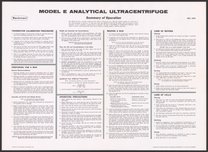Beckman Model E Ultracentrifuge Rotor
- 1950s

Rights
 BY 4.0
BY 4.0Download all 3 images
PDFZIPof full-sized JPGsDownload selected image
Small JPG1200 x 1477px — 79.0 KBLarge JPG2880 x 3544px — 349 KBFull-sized JPG3537 x 4353px — 527 KBOriginal fileTIFF — 3537 x 4353px — 44.1 MB
 This work is licensed under a Creative Commons Attribution 4.0 International License.
This work is licensed under a Creative Commons Attribution 4.0 International License.Beckman Instruments began producing centrifuges after their January 1, 1955 acquisition of industry leader, Specialized Instruments Corporation, or Spinco. With Spinco came the famous Model E Ultracentrifuge, which was developed in 1947 and was used for many important scientific discoveries of the 20th century, like the 1957 CalTech experiment that proved James Watson and Francis Crick’s theory on DNA replication.
The ultracentrifuge is a centrifuge optimized for spinning a rotor at very high speeds, capable of generating acceleration as high as 1,000,000 g (approx. 9 800 km/s²). There are two kinds of ultracentrifuges, the preparative and the analytical ultracentrifuge. Both classes of instruments find important uses in molecular biology, biochemistry, and polymer science. This analytical ultracentrifuge rotor is a black, oval-shaped device. The rotor has two holes, one to hold a sample cell and the other to hold a balance cell. The top of the rotor has a sharp needle, and the device is stabilized on a red plastic base.
| Property | Value |
|---|---|
| Creator of work | |
| Place of manufacture | |
| Format | |
| Genre | |
| Medium | |
| Extent |
|
| Language | |
| Subject | |
| Rights | Creative Commons Attribution 4.0 International License |
| Credit line |
|
Institutional location
| Department | |
|---|---|
| Physical container |
|
Related Items
Cite as
Science History Institute. Beckman Model E Ultracentrifuge Rotor. Photograph, 2021. Science History Institute. Philadelphia. https://digital.sciencehistory.org/works/9wju96o.
This citation is automatically generated and may contain errors.







